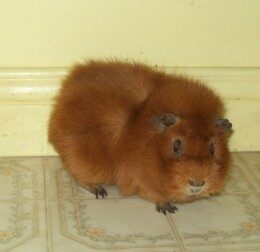Cavies are intelligent, interesting pets. They originated in South America and were first brought to Europe in the 16th Century. The second word in their scientific name, Cavia porcellus, means ‘little pig’ in Latin. Contrary to popular opinion, cavies are more closely related to chinchillas and porcupines than to rodents such as rats, mice or squirrels.

Cavies are most commonly known as Guinea Pigs. They have been extensively studied in the laboratory so there is plenty of data available on their diseases, reproduction and normal physiology. Scientists like Louis Pasteur began experimenting on cavies in the 1870’s. Over time, millions of cavies have been used to research nutrition, pharmacology, allergies, genetics and other research projects that have benefited mankind. Compared to other laboratory animals, cavies have the reproductive system that is most similar to humans.
Terminology:
Adult Male: Boar
Adult Female: Sow
Baby: Pup
Boar Size: 900-1200g
Sow Size: 700-900g
Birth weight: 70-100g
Average Lifespan: 4-5 yrs
Normal Vital Signs:
Heartrate: 240-280 beats per minute
Respiration rate: 60-90 breaths per minute
Temperature: 102.2°F - 104°F
Notes on Vital Signs:
The heartrate can be felt by placing your fingers on the cavy’s chest, just behind its elbow.
Respiration rate can be seen by carefully watching the cavy’s flanks, though this is difficult.
Normal body temperature can vary 2-3° from that of other cavies. So it is important to know the normal temperature of your particular cavy.
Heat Cycle Length: 15-17 days
Gestation period: Approximately 63 days
Litter Size: 2-5 with an average of 3
Cavy Care
Cavies require a similar environment to humans. They are susceptible to heat and cold and need to be kept in a draft free environment. If the cavy lives in the home with humans, it will usually thrive well because if the family is comfortable, the cavy is usually comfortable as well. The larger the cage, the better as they like to exercise. Cavies can also run around on the floor, but they need to be watched to ensure they don’t get into something that will hurt them. They can sometimes be litter trained, but not as successfully as rabbits.
Commercially available feed is sufficient for cavies, however they should be fed fresh fruits and vegetables regularly. Cavies aren’t able to produce their own vitamin C, so without fresh foods, they can become deficient. They also like good quality dry hay, both to eat and burrow in. Pelleted feed should be fed in a heavy dish they can’t tip over and they should be watered with a water bottle. Any feeding equipment should be kept clean. Utensils can be washed with soap and water, then rinsed well.
Common Diseases
Cavies tend to be healthy creatures that rarely get a disease; however, there are a few common problems that cavies encounter such as fungal infections, external parasites, bumblefoot, and pregnancy toxaemia.
Mycosis
Mycosis is the name used for a variety of fungal skin infections that cavies can get. These infections can also be transmitted to humans. They are rarely serious in humans or cavies. Cavies are more prone to fungal infections in the spring and summer. Their coat will get greasy and the hair tends to fall out. They will also have heavy dandruff, often around the jaws and top of the head. Affected cavies will scratch often, sometimes to the point of causing lesions on the skin. If untreated, continued scratching of these lesions will cause the cavy to have fits almost like seizures. It is unlikely that the cavy will die from a fungal infection. I have treated these infections by mixing a few drops of tea tree oil with vegetable oil and rubbing this into the skin, focusing on the areas with heavy dandruff. After leaving the oil in for 1-3 days, I shampoo it out with anti-dandruff shampoo, or just regular shampoo if I don’t have the anti-dandruff kind. This has always cleared up the infection.
Mites
Cavies can get external parasites such as mites and lice. The cavy will get small bald patches and the lice will be visible running around on the body. They can be treated with subcutaneous injections of dewormer, or a flea dust. Anti-parasitic shampoos can also be used. As a general rule, anything that is safe for use on cats, is safe for cavies, but you should always consult a vet before using a drug on your cavy.
Pregnancy Toxemia
Prevention is better than cure as cavies rarely recover from pregnancy toxemia. Toxemia occurs in late pregnancy, often to overweight sows. It also can occur in sows carrying a lot of babies. The cause of toxemia isn’t fully understood, though this condition could be loosely compared to Preeclampsia in humans. Symptoms include severe lethargy and loss of appetite. Often the babies are dead, and this can be confirmed by holding the sow and feeling for movement. The sow can be encouraged to eat and can be given fluids with an eyedropper. If she is close to her due date and her pelvic bones are open, a vet can give oxytocin to attempt to stimulate contractions and get the babies born. To prevent pregnancy toxemia, it’s important to keep sows from getting fat and to feed a high quality diet rich in vitamin C and Calcium. Alfalfa is a good source of nutrients for a pregnant cavy.
Bumblefoot
This is a condition where the footpad swells, then the skin breaks and scabs form. The cavy will limp, but this isn’t a serious condition. Usually it will heal on its own, but if it doesn’t, a fungal problem should be suspected.
Breeding Cavies
There are a few important things to know when breeding cavies. A cavy pup is born fully furred with its eyes open. They look like very tiny adults. They can eat solid food their first day, though they will nurse from their mother for 3-4 weeks.
Female cavies MUST be bred so they have babies before 1 year of age. Some experts say they must have babies before 6 months. The reason for this is that the cavy’s pelvic bones will fuse together around 1yr of age and make it impossible to deliver the babies. Females should weigh at least 500g before being bred as being any smaller might result in complications.
Cavy gestation lasts approximately 63 days, and the sow will have the entire litter in 5-30 minutes if everything is normal.
Sounds a Cavy Makes
Wheeping: This is the most common cavy sound and usually means they want food. Most cavies learn to recognize the sound of the fridge door opening and will ask for treats.
Shrieking: This sound means the cavy is either hurt, or scared.
Purring and Rumbling: This sound is similar to a cat purring. This sound is used for courtship and friendship. When it escalates to rumbling, it means one cavy is mad at another.
